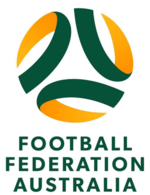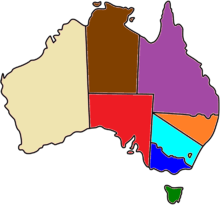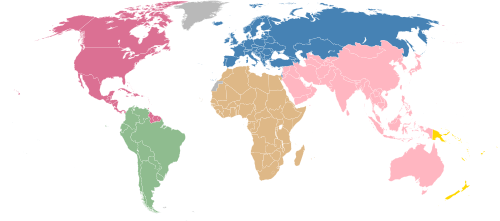Football Federation Australia
| AFC | |
|---|---|
 | |
| Founded |
|
| Headquarters | Sydney |
| FIFA affiliation | 1963 |
| AFC affiliation | 2006 |
| AFF affiliation | 2013 |
| Chairman | Steven Lowy |
| Website | FootballAustralia.com.au |
Football Federation Australia (FFA) is the governing body of soccer, futsal, and beach soccer within Australia.[1] The FFA is headquartered in Sydney. Although the first governing body of the sport was founded in 1911, FFA in its current form was only established in 1963 as the Australian Soccer Federation. It was later reconstituted in 2003 as the Australian Soccer Association before adopting its current name in 2005.
FFA oversees the men's, women's, youth, Paralympic, beach and futsal national teams in Australia, the national coaching programs and the state governing bodies for the sport. It sanctions professional, semi-professional and amateur soccer in Australia. FFA made the decision to leave the Oceania Football Confederation (OFC), for which it was a founding member, and become a member of the Asian Football Confederation (AFC) on 1 January 2006.
History
FFA's origins lie as far back as 1911, with the formation of the "Commonwealth Football Association".[2] This body was then superseded by the Australian Soccer Football Association, which was formed in 1921, with its headquarters in Sydney.[3] The Australian Soccer Football Association operated for forty years, was given FIFA provisional membership in November 1954[4] and this was confirmed in June 1956,[5] however in 1960, the association disbanded after being suspended from FIFA for the poaching of players from overseas.[3] In 1961 the Australian Soccer Federation was formed as a potential successor to the former governing body for the sport. However, this association was refused re-admittance to FIFA until outstanding fines had been paid, which was later done in 1963, seeing the new national body admitted to FIFA.[3]
Isolated from international football, Australia repeatedly applied to join the Asian Football Confederation in 1960,[6] and in 1974[7] but were denied in all requests. Australia with New Zealand eventually formed the Oceania Football Federation (now Oceania Football Confederation) in 1966.[8] Australia resigned as an OFC member in 1972 to pursue membership with the AFC, but they rejoined in 1978.[9][10]
In 1995, the Australian Soccer Federation formally changed its name to Soccer Australia.[3]
In 2003, following Australia's failure to qualify for the 2002 FIFA World Cup, allegations of fraud and mismanagement were levelled at Soccer Australia by elements within the Australian Press including the ABC.[11] Soccer Australia commissioned an independent inquiry known as the Crawford Report as a result of the Australian Government's threat to withdraw funding to the sport. The Australian Government could not interfere as any political interference would have constituted a breach of FIFA Statutes. The findings of the report were critically analysed by the board of Soccer Australia who believed that the recommendations contained therein were not capable of being implemented. The report recommended, among other things, the reconstitution of the governing body with an interim board headed by prominent businessman Frank Lowy. Some three months after Lowy's appointment Soccer Australia was placed into liquidation and Australia Soccer Association (ASA) was created without encompassing the Crawford Report recommendations and effectively disenfranchising all parties who had an interest in Soccer Australia. The Australian Government provided approximately $15 million to the ASA.[12]
On 1 January 2005 ASA renamed itself to Football Federation Australia (FFA), aligning with the general international usage of the word "football", in preference to "soccer", and to also distance itself from the failings of the old Soccer Australia. It coined the phrase "old soccer, new football" to emphasise this.[3]
On 1 January 2006, Football Federation Australia moved from the OFC to the AFC.[3] The move was unanimously endorsed by the AFC Executive Committee on 23 March 2005, and assented by the OFC on 17 April. The FIFA Executive Committee approved the move on 29 June, noting that "as all of the parties involved ... had agreed to the move, the case did not need to be discussed by the FIFA Congress", and was unanimously ratified by the AFC on 10 September.[13][14][15] FFA hoped that the move would give Australia a fairer chance of qualifying for the FIFA World Cup and allow A-League clubs to compete in the AFC Champions League, thereby improving the standard of Australian football at both international and club levels with improved competition in the region.[16]
In February 2008, FFA formally announced their intention to bid for the 2018 FIFA World Cup, 2022 FIFA World Cup and the 2015 AFC Asian Cup.[17][18] In 2010, the decision was made by FFA to withdraw its World Cup bid for 2018, instead focusing on a bid for the 2022 tournament.[19] FFA failed in its $45.6 million bid for the 2022 World Cup having received only one vote from the FIFA Executive.[20]
In 2013, Australia was admitted as a full member to the ASEAN Football Federation (AFF), after they formally joined as an invite affiliation to the regional body in 2006.[21]
On 29 January 2015, after the defeat of Iraq and the United Arab Emirates during the 2015 AFC Asian Cup, West Asian Football Federation members reportedly sought to remove Australia from the AFC primarily due to "Australia benefiting hugely from Asian involvement without giving much in return".[22]
Administration

Football in Australian has used a federated model of national, states and territories governing bodies since the first state body was established in New South Wales in 1882. Local associations and regional zones were set up within the states and territories as football expanded and from time to time informal groups of clubs have augmented the formal structures. Today, there is one national governing body, nine state and territory member federations and over 100 district, regional and local zones and associations.
Corporate structure
Board of directors
| Office | Name | Tenure |
|---|---|---|
| Chairman | Steven Lowy | 2015–present |
| Deputy chairman | Brian Schwartz | |
| Director | Moya Dodd | |
| Director | Joseph Healy | |
| Director | Chris Rex | |
| Director | Peter Tredinnick | |
| Director | Phillip Wolanski |
Senior management
- David Gallop – chief executive officer
- Mark Falvo – chief operating officer
- Luke Bould – chief commercial officer
- Han Berger – National Technical Director
- Greg O'Rourke – Head of Hyundai A-League
- Luke Casserly – Head of National Performance
- Emma Highwood – Head of Community Football
- Tim Holden – Head of Legal & Business Affairs and Integrity
- Jo Setright – Company Secretary
Competitions
FFA organises several national competitions, with state-based competitions organised by the respective state governing football federations.
See also
References
- 1 2 "Who We Are". Football Federation Australia.
- ↑ "Football – Commonwealth Association". The Brisbane Courier. 16 April 1914. Retrieved 18 October 2013.
- 1 2 3 4 5 6 "Timeline of Australian Football". migrationheritage.nsw.gov.au. Archived from the original on 17 December 2014. Retrieved 18 October 2013.
- ↑ Roy Hay, Bill Murray (2014). A History of Football in Australia: A Game of Two Halves. Hardie Grant Books. p. 291.
- ↑ "Come back in 2 years, says FIFA". The Straits Times. Reuters, United Press International. 11 June 1956.
- ↑ "AFC turns down an application by Australia". The Straits Times. 8 August 1960.
- ↑ "AFC turn down Aussie application". The Straits Times. 15 September 1974.
- ↑ "History". oceaniafootball.com. Retrieved 18 October 2013.
- ↑ OFC History Archive index at the Wayback Machine. oceaniafootball.com
- ↑ "Oceania admit Taiwan and Aussies quit". The Straits Times. Reuters, United Press International. 1 March 1976.
- ↑ "The World Today - Soccer Australia reforms". www.abc.net.au.
- ↑ Presenter: Mark Colvin, Reporter: Ross Solly (26 September 2003). "Soccer Australia officially canned". PM. Transcript. ABC Local Radio.
- ↑ "Other executive decisions". FIFA. 29 June 2005. Retrieved 25 November 2013.
- ↑ "FIFA approves Australia move" (PDF). FIFA. Archived from the original on 19 October 2013. Retrieved 19 October 2013.
- ↑ "Put Asian football first: Bin Hammam". AFC Asian Football Confederation. 11 September 2005.
- ↑ "Australia gets President's blessing to join AFC in 2006". Australian Broadcasting Corporation. Retrieved 18 October 2013.
- ↑ Smithies, Tom (23 February 2008). "Lowy's vision for soccer". The Daily Telegraph. Archived from the original on 5 February 2009. Retrieved 25 February 2008.
- ↑ "Let's land the World Cup". The Age. Melbourne. 24 February 2008. Retrieved 25 February 2008.
- ↑ "Australia to focus on 2022 Bid". FIFA. 12 June 2010. Retrieved 23 June 2010.
- ↑ "FFA receive A$45m for World Cup bid". Sport Business. Retrieved 20 November 2009.
- ↑ "Australia joins ASEAN family". theworldgame.sbs.com.au. Retrieved 8 November 2013.
- ↑ Hassett, Sebastian (29 January 2015). "Angry Gulf nations leading charge to kick Australia out of Asian Football Confederation". The Sydney Morning Herald. Retrieved 1 May 2018.
